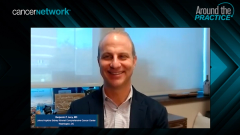
IMpower010 and KEYNOTE-091: Adjuvant Immunotherapy in NSCLC
Expert perspectives on the IMpower010 and KEYNOTE-091 trials, which assessed adjuvant immunotherapy in non–small cell lung cancer.
Episodes in this series

Transcript:
Charu Aggarwal, MD, MPH:Let’s turn to the data on adjuvant therapy. Heather, do you mind leading us through IMpower010 and the implications?
Heather Wakelee, MD, FASCO: Sure, I’m happy to talk about that. Also, I’ll briefly mention KEYNOTE-091 because we now have a second trial that’s come out as well. With IMpower010, this enrolled patients who had completely resected stage IB, II, and IIIA non–small cell lung cancer. It ended up being mostly stage II. They were at 10% to 12% stage IB, and 40% or so IIIA. I bring that up because as we talk about the neoadjuvant trials and the adjuvant trials, there’s often a different ratio of different stages. We’ve got to be really careful when we start doing the cross-trial comparisons, which we of course will all do though we’re not supposed to, and look at what those outcomes are. What are the median survivals? You’ve got to make sure that you’re doing the apples to apples comparisons. It still is 40% stage IIIA, so a very small stage I patient population. The patients who were enrolled were stratified on several different factors. They all got chemotherapy, so that’s different from some of the other adjuvant trials. Then those who got through chemotherapy and still wanted to keep going on treatment were randomized, it was just over a thousand patients, to get atezolizumab or to get best supportive care. There was no placebo on the study.
The study also had a complicated statistical testing plan. The first group looked at patients with stage II to IIIA disease who had PD-L1 expression. This was using the SP263 assay. Again, for a lot of people, it’s like, why do we care about the specifics of the PD-L1 assays? But it does matter, mostly because the SP142, which was historically used with atezolizumab, is an outlier because it looks at both the immune infiltrating cells, as well as the tumor cells for that PD-L1 number. Almost all the other assays, including the 22C3 that’s used with pembrolizumab, or this SP263, just look at the tumor cells. When IASLC [International Association for the Study of Lung Cancer] did their blueprint project in the past, everything was very closely aligned except the SP142. On this trial, initially, we had planned to use the SP142, but then as all of the metastatic world was evolving, we realized that was very much the outlier. All the analyses were in the end done with the SP263. This is a caveat, but an important one. I think most folks in the community, certainly at our center, use the tissue-based testing. Whether you are doing the 22C3, or a lot of centers use the SP263, they’re very closely aligned. A tangent there. But 55% of patients enrolled on this trial had PD-L1 expression based on the SP263 assay. The first group tested, stage II to IIIA with PD-L1 expression, had a disease-free survival hazard ratio of 0.66, which is highly statistically significant. It’s that subgroup where we have the FDA approval for atezolizumab. The patient we’ve been talking about fits into that group.
The next strata that was looked at were patients with stage II to IIIA disease, regardless of PD-L1 expression. There’s still a statistically significant disease-free survival with a hazard ratio that’s 0.79, but it wasn’t as good. Then when we bring in the stage IB patients, there hadn’t yet been enough events at the data cut that we presented so far to call it, but it didn’t change a whole lot. It was around 0.81. There are no overall survival data that are definitive. The trends are looking positive in that the curves are starting to separate even though the drug was stopped after 1 year. So they’re continuing to separate, but we don’t know yet. It’s too early.
I think what’s very striking about these results is what’s hinted at with the hazard ratio of 0.66 for only the PD-L1 expressing, going to 0.79. When we broke it out further, if you look at patients whose tumors have no PD-L1 expression, there’s really no benefit in this trial. I think that’s important because to me, ideally, we find a treatment that works for everybody. But if we don’t, we need to be able to figure out who does and doesn’t get a benefit, because we haven’t really talked about adverse events too much yet today. But we’ve all seen patients who’ve had significant adverse events from immune therapy, so you want to make sure that you’ve got a higher probability of benefit before you’re giving these drugs to everybody. So, I look at that, and the fact that with IMpower010, when we dive deeper, with no PD-L1 expression there was no benefit. With a PD-L1 expression of greater than 50% on the tumor, the disease-free survival hazard ratio is 0.43, so really impressive. This patient fits into that, and so clearly is very likely to benefit from the adjuvant atezolizumab.
In the 1% to 49% range, the hazard ratio is 0.87. We haven’t looked to see the different cut points, so that whole group together may not benefit, but maybe some benefit? It’s a little unclear for the no PD-L1 expression, no benefit. This is what we’re teasing apart while trying to look for other biomarkers or other things that make sense. There’s a little bit of ctDNA [circulating tumor DNA] data from the trial, but I don’t think it helped us that much. We also saw that in patients with higher stage disease, there was more benefit. So if you didn’t have nodal involvement, there was not so much benefit; at stage III, clear benefit; and stage II, somewhere in between. We also looked at a few other things, like smoking status, which didn’t make a lot of sense because there, less smoking seemed better. We looked at EGFR mutation status, and if there was an EGFR mutation and PD-L1 expression, there was maybe benefit.
So, it’s very difficult to tease it all out, but where it gets particularly confusing is when we look at the KEYNOTE-091 data, which was with adjuvant pembrolizumab. The trial was very similar other than different drugs, but a very similar patient population enrolled. They did have an option of not getting chemotherapy, so that was one difference, and it was a placebo-controlled study. Their overall disease-free survival hazard ratio is 0.76. That’s really close to the 0.79 for the stage II to IIIA all comers regardless of PD-L1 expression in IMpower010. But where it gets really different is that in the KEYNOTE-091, PD-L1 status did not matter. The hazard ratio for the patients who had the high PD-L1 of at least 50% was 0.82. So, it was worse than for the all-comer population. That is in contrast with IMpower010, where for the greater than 50%, it was 0.43, it was 0.66 for any PD-L1 expression, 0.79 regardless, but that was all being driven by the greater than 50%. And here, the greater than 50% doesn’t matter, and so you can look at that from a couple of different ways and just say oh, well, everybody’s benefiting. Or you can look at it from the perspective of PD-L1 not being the biomarker here. We’re not actually helping everybody, but we don’t know how to pick the patients who are benefiting, and that is super confusing to me.
The other thing that was very confusing in this trial was the patients with stage IIA disease were the least likely to benefit if you look at the forest plots, which again, doesn’t make sense. In every other adjuvant trial, higher disease; to me, I look at it simply as, higher stage disease, higher probability of recurrence, a higher chance of benefit because you can do more when you’ve got a higher risk. That’s a simple way of thinking about it. So that doesn’t make sense either. Then there were a couple of things that make more sense, like…the patients who were actively smoking, had more benefit. That was something that didn’t make sense in IMpower010. Another thing that’s very unusual, for patients who have an EGFR mutation, they were one of the groups that had the most benefit in this trial with pembrolizumab. In IMpower010, we also saw a hint, but it wasn’t as pronounced.
So there’s a whole lot that doesn’t make sense right now, but we do have 2 positive trials, solidifying that immune therapy in the adjuvant setting can be helpful. But I don’t think we understand fully who were the patients who truly benefited, because in both of these trials, there were absolutely patients who had immune-mediated adverse events. There is some risk, including even risk of fatality, though it’s low, so we need to be on guard for that. Maybe I went through that in a little too much detail, but it’s so interesting because of these differences. And of course, we’ve got a couple more trials reading out at some point in the near future, which will hopefully help us understand this a little better.
Transcript edited for clarity.
Newsletter
Stay up to date on recent advances in the multidisciplinary approach to cancer.


























































































